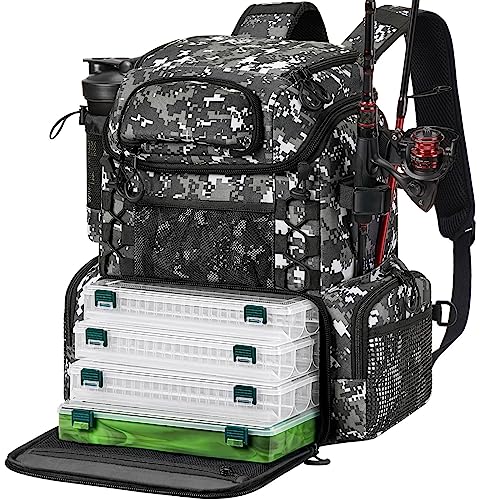Introduction: A Tasty Adventure Awaits on the Water
Have you ever wondered how to transform your fresh catch into a delicious meal that showcases the unique flavors of freshwater fish? Fishing for flavor is an art, and we're here to guide you through this tasty adventure. From selecting the right species to preparing and cooking your catch, there's a world of culinary possibilities to explore. So, let's dive into the ultimate fusion of fishing and food, as we uncover the secrets to creating mouthwatering dishes that will impress even the most discerning palate.
A Diverse Array of Freshwater Fish
The world of freshwater fish offers a diverse array of species, each with its own unique flavor, texture, and culinary potential. Here's a glimpse into the fascinating world of these aquatic delights:
- Common Species: When it comes to freshwater fishing, some of the most popular and widely available species include trout, bass, catfish, and pike. These fish are sought-after by anglers and chefs alike for their distinct characteristics and versatility in the kitchen.
- Regional Variations: One of the exciting aspects of freshwater fish cooking is the discovery of unique species found in different regions. For example, perch and sunfish are commonly enjoyed in the Midwest, while walleye is a beloved delicacy in the North. In Southern states, you might find delicious crappie and bluegill on local menus.
- Sustainability Considerations: As responsible anglers and food enthusiasts, it's crucial to prioritize sustainable fishing practices. Respecting fish populations and the environment ensures that our favorite species thrive for future generations. Always follow local regulations, and seek out fisheries or suppliers that practice sustainable fishing and responsible sourcing.
Buying and Storing Freshwater Fish
Selecting and storing freshwater fish is the first step toward a delicious meal. Here's what you need to know to make the right choices:
- Selecting Fresh Fish: When buying fresh fish, look for firm flesh that bounces back when gently pressed. Clear, bright eyes and shiny, moist gills are also indicators of freshness. A mild, seawater-like scent is typical, but avoid any strong or unpleasant odors.
- Storing Techniques: Proper storage is key to maintaining freshness. Refrigerate whole fish or fillets in the coldest part of your fridge, typically the bottom shelf, and consume within 2-3 days. For longer storage, freezing is an option. Wrap fish tightly in plastic wrap or place it in an airtight container, ensuring all air is removed. Frozen fish will maintain its best quality for 2-3 months.
- Marketplace Options: You can source freshwater fish from various places, including local fish markets, specialty seafood shops, supermarkets, or directly from fisheries or fish farms. Chat with the vendors to learn about the source and freshness of their offerings.
Essential Preparation Techniques

Mastering the art of preparing freshwater fish involves a few key techniques:
- Cleaning and Filleting: The first step in preparing your catch is to clean and fillet it efficiently. Start by scaling the fish, then gut it with a sharp knife, removing all internal organs. For filleting, make a slit behind the gills and another along the spine, then carefully cut the flesh away from the bones.
- Portioning and Cutting: Depending on your recipe, you might need to portion your fish into steaks, cutlets, or cubes. For steaks, cut across the body at your desired thickness. For cutlets, remove the backbone and slice the fish diagonally. Cubing is ideal for skewers or stir-fries.
- Deboning and Skinning: Deboning fish ensures a pleasant dining experience, free from unwanted bones. Use needle-nose pliers or tweezers to gently pull out small bones, working over a bright light to spot them easily. Removing the skin is optional, but it can be done easily with a sharp knife, starting at the tail and working your way to the head.
Delicious Recipes to Tempt Your Taste Buds
Now, let's dive into some mouthwatering recipes that showcase the versatility and flavor of freshwater fish:
- Grilled Trout with Lemon and Herbs: This classic preparation highlights the delicate flavor of trout. Simply stuff the cavity with lemon slices and fresh herbs like thyme or rosemary, then grill over medium heat until the flesh flakes easily.
- Catfish Tacos with Spicy Slaw: Catfish takes on a tasty twist in this fusion dish. Coat catfish fillets with a crispy cornmeal batter, then pan-fry until golden. Serve in warm tortillas with a zesty slaw of shredded cabbage, carrots, and a spicy mayonnaise sauce.
- Pan-Seared Bass with Garlic Butter: Bass is the star of this simple yet flavorful dish. Season bass fillets with salt and pepper, then pan-sear in butter over medium-high heat for 3-4 minutes per side. Finish with a generous drizzle of garlic butter and a sprinkle of fresh parsley.
Exploring Regional Cuisine
Freshwater fish cooking takes on unique characteristics in different regions, and here are some delicious examples:
- Cajun-Style Fish Gumbo: Originating from the Southern United States, gumbo is a hearty and spicy stew. It often features catfish or bass, slowly simmered with sausage, okra, and a mix of vegetables in a rich, flavorful broth. Serve it over rice for a true taste of the Bayou.
- German Fish Soup (Fischsuppe): This traditional European soup showcases the delicate flavors of river fish. A clear, flavorful broth is infused with vegetables and a variety of freshwater fish, such as pike, perch, and trout. It's a simple yet elegant dish, often served with crusty bread.
- Thai Green Curry with Fish: Take your taste buds on an exotic journey with this flavorful curry, often made with snakehead or tilapia. The fish is simmered in a vibrant green curry paste, coconut milk, and an array of herbs, creating a dish that's both aromatic and delicious.
Cooking Techniques for Perfect Results
Mastering a few key cooking techniques will ensure your freshwater fish dishes turn out perfectly every time:
- Grilling and Barbecuing: Grilling and barbecuing are fantastic ways to cook freshwater fish, adding a smoky flavor. To prevent sticking, oil the grill grates well and preheat them. Cook fish over medium heat, and consider using a fish basket or grill mats for easier handling.
- Pan-Frying and Searing: For a crispy exterior and moist, flaky flesh, pan-frying and searing are ideal. Choose a non-stick pan and a combination of butter and oil for flavor and browning. Sear fish for a few minutes on each side, then reduce the heat to finish cooking through.
- Poaching and Steaming: Gentle cooking methods like poaching and steaming preserve the delicate flavors and textures of freshwater fish. Poach fish in a flavorful court-bouillon or white wine broth, or steam it over simmering water for a light and healthy dish.
Enhance Your Meal with Side Dishes and Accompaniments
No culinary journey is complete without delicious side dishes to round out the experience:
- Crispy Fish Skins: Don't discard those fish skins! Transform them into a tasty snack or side dish. Simply crisp them up in a hot pan with a drizzle of oil, then serve with a tangy dipping sauce.
- Lemon-Dill Rice Pilaf: Brighten your plate with this flavorful rice dish. Cook rice in a broth infused with lemon zest, dill, and a hint of garlic. It's the perfect accompaniment to absorb rich sauces or balance simply prepared fish.
- Grilled Vegetable Medley: Fire up the grill for a colorful and healthy mix of vegetables. Zucchini, bell peppers, eggplant, and onions are brushed with olive oil and grilled to perfection, complementing the freshness of your freshwater fish.
Tips for Cleaning and Maintaining Your Catch

To ensure your catch remains in prime condition, follow these essential cleaning and maintenance tips:
- Cleaning Your Catch: It's best to clean and gut your fish as soon as possible after catching them. Use a sharp, flexible knife to gut the fish, removing all internal organs. Rinse the cavity and scales thoroughly with cold water.
- Storing and Freezing: Store fresh fish in the coldest part of your fridge, and consume within a few days. For longer storage, vacuum seal your fish or place it in an airtight container before freezing. Frozen fish will maintain its quality for up to 3 months.
- Defrosting and Preparing Frozen Fish: When ready to use frozen fish, thaw it slowly in the refrigerator overnight. Alternatively, place the sealed package in cold water for quicker defrosting. Ensure the fish is thoroughly defrosted before cooking.
FAQs: Troubleshooting Common Concerns
Let's address some frequently asked questions and provide solutions to potential problems:
- "My fish sticks to the grill. How can I prevent this?" Answer: Ensure your grill grates are well-oiled and preheated. Also, try using a fish basket or grill mat for easier handling and release.
- "What do I do if my fish falls apart when cooking?" Answer: This can happen with more delicate fish. Try using a fish spatula, and handle the fish gently during cooking. Also, ensure your cooking surface is non-stick and well-oiled.
- "How can I tell if my fish is cooked properly?" Answer: The flesh should be opaque and flake easily with a fork. The internal temperature should reach 145°F. . Also, the fish will lose its translucency and turn opaque.
Conclusion: A Culinary Adventure Unveiled
Fishing for flavor has taken us on a delightful journey, exploring the culinary potential of freshwater fish. From selecting the right species to preparing and cooking delicious dishes, we've uncovered a world of tastes and techniques. Whether you're an angler or a food enthusiast, embracing these recipes and tips will surely impress and satisfy.
Final Thoughts: Bon Appétit!
We hope this guide has inspired you to embark on your own tasty adventures with freshwater fish. Remember, cooking with freshwater fish is an art that combines respect for nature's bounty with culinary creativity. So, bon appétit, and happy fishing for flavor!
Resources and Further Exploration
- "The Freshwater Fish Cookbook" by Susan Hughes - A comprehensive cookbook featuring recipes and techniques for cooking a variety of freshwater fish.
- "The Angler's Guide to Fish Cooking" by Chef John Rivers - A guide to preparing and cooking freshwater fish, with tips and recipes from a renowned chef.
- "The Joy of Fish Cooking" by Marie Simmons - A celebration of fish and seafood, including freshwater delights, with a focus on flavor and simplicity.
These resources will further enhance your culinary journey, providing a wealth of recipes, techniques, and inspiration.
Now, go forth and create delicious memories, one fish at a time!
Next Steps: Continue the Adventure with Saltwater Fish
If you've enjoyed exploring freshwater fish cooking, why not dive into the world of saltwater fish? From salmon to seabass, and from tuna to swordfish, there's a whole new realm of flavors and culinary techniques to discover. Stay tuned for our upcoming blog, where we'll unravel the secrets of cooking saltwater fish, taking your taste buds on yet another extraordinary adventure.





